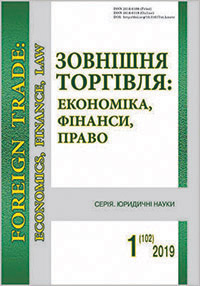Singapore convention: theoretical and legal analysis
DOI:
https://doi.org/10.31617/zt.knute.2019(102)03Keywords:
mediation, SingaporeConvention, mediationagreement, international commercial dispute.Abstract
Background. The search for effective and fair mechanisms for resolving disputes remains an integral part of the development of international business, as evidenced by the adoption and improvement of international legal acts and national legislation of the leading countries of the world. In August 2019, Singapore is scheduled to sign the UN Convention on the International Peace Agreements concluded as a result of mediation developed by UNCITRAL Working Group II. The popularity of mediation in international commercial activities will obviously increase with the possibility of accelerating the implementation of mediation agreements in national jurisdictions. At the same time, mechanisms for recognizing and enforcing mediation agreements are significantly different, or not provided at all, by national legislation.
Analysis of recent research and publications. The resolution of disputes in international commercial activities is the subject of research by domestic and foreign specialists, in particular, N. Gaidaienko-Sher, O. Goncharenko, A. Ovcharova, L. Ivanova, M. Mazina, E. Sussman, E. Chua and others. In view of the the recent harmonization of the final text of the Singapore Convention, a full-fledged analysis of its content has not yet been carried out by Ukrainian researchers, which actualizes the relevant scientific publication.
The purpose of the article is a theoretical and legal analysis of the UN Convention on the International Peace Agreements concluded as a result of mediation.
Materials and methods. The normative basis of the study is international treaties and standard laws of UNCITRAL, materials of Working Group II of UNCITRAL. The methodological basis of the research was the general scientific and special legal methods of cognition.
Results. The article is devoted to the analysis of the text of the UN Convention on International Settlement Agreements Resulting from Mediation, the text of which was agreed in 2018 by UNCITRAL Working Group II. Following the signing in 2019, the convention will be called the Singapore Convention, and together with the UNCITRAL Model Law on International Commercial Mediation and International Settlement Agreements Resulting from Mediation will form the basis for the development and wider use of extrajudicial forms of resolution of international commercial disputes, in particular mediation procedures. The benefits of mediation in comparison with judicial or arbitral proceedings are universally recognized, while the legal force of the mediation agreement is one of the determining factors in the parties' decision to apply to the mediation procedure or to the trial.
The popularity of mediation in international commercial activities will obviously increase with the possibility of accelerating the implementation of mediation agreements in national jurisdictions, at the same time, today the mechanisms for recognizing and enforcing mediation agreements are significantly different, or not at all, by national legislation.The Singapore Convention is aimed at eliminating such a problem. The article analyzes the key aspects of the mentioned international legal document: sphere of application, definition of the criterion of "internationality" of the mediated dispute, the concept of "commercial dispute", interpretation of the term "mediation", requirements for confirmation of the fact of carrying out of the mediation procedure, Grounds for refusing to grant relief. The author refers to certain analogies with the New York Convention of 1958.
Conclusion. The author comes to the conclusion about the cumulative effect of the development and signing of the Singapore Convention, which will be to address the stakeholders of international business for mediation, in addition, the Convention may become a factor in popularizing mediation procedures, institutionalizing mediation in national legislation, and introducing appropriate changes to civil and commercial procedural norms.
References
JuNSITRAL. Tipovoĭ zakon o mezhdunarodnoĭ kommercheskoĭ soglasitel'noĭ procedure i Rukovodstvo po prinjatiju i primeneniju, 2002 god [UNCITRAL. Model Law on the International Commercial Conciliation Procedure and the Guide to the Adoption and Application, 2002]. Retrieved from http://www.uncitral.org/pdf/russian/texts/arbitration/ml-conc/03-90955_Ebook.pdf [in Russian].
United Nations Convention on International Settlement Agreements Resulting from Mediation. Retrieved from http://www.uncitral.org/pdf/english/commissionsessions/51st-session/Annex_I.pdf [in English].
Gajdaenko-Sher, N. (2017). Konvencija o privedenii v ispolnenie mirovyh soglashenij,dostignutyh v rezul'tate mezhdunarodnoj kommercheskoj soglasitel'noj procedury: v nachale puti [Convention on the enforcement of international agreements reached as a result of an international commercial conciliation procedure: at the beginning of the journey]. Zhurnal rossijskogo prava – Journal of Russian Law, 3 (243), 157-168 [in Russian].
Goncharenko, O. (2014). Perevagy rozgljadu komercijnogo sporu Arbitrazhnym Instytutom Stokgol'ms'koi' Torgovoi' Palaty [Benefits of considering a commercial dispute by the Arbitration Institute of the Stockholm Chamber of Commerce]. Ukrai'ns'kyj chasopys mizhnarodnogo prava – Ukrainian Journal of International Law, 4, 66-70 [in Ukrainian].
Ovcharov, A., Ivanova, L., & Mazin, N. (2018). Sovremennye pravovye mehanizmy razreshenija mezhdunarodnyh jekonomicheskih sporov [Modern legal mechanisms for resolving international economic disputes]. Lex Russica, 3 (136), 143-152 [in Russian].
Sussman E. (2018). The Singapore Convention. Promoting the Enforcement and Recognition of International Mediated Settlement Agreements. ICC Dispute Resolution Bulletin, 3 [in English].
Chua,E. (2019). The Singapore Convention on Mediation–A Brighter Future for Asian Dispute Resolution. Asian Journal of International Law, 1-11. DOI: https://doi.org/10.1017/S2044251318000309 [in English].
Proposal by the Government of the United States of America: future work for Working Group II, A/CN.9/822 (Jun. 2, 2014) [in English].
Mazaraki, N. A. (2018). Vykonannja ugody, ukladenoi' za rezul'tatamy mediacii'. Aktual'ni problemy vitchyznjanoi' jurysprudencii' [Implementation of an agreement concluded on the results of mediation. Actual problems of domestic jurisprudence]. Retrieved from http://apnl.dnu.in.ua/1_2018/6.pdf [inUkrainian].
Dyrektyva № 2008/52/JeS Jevropey̆s'kogo parlamentu i Rady pro dejaki aspekty poserednyctva (mediaciï) v cyvil'nyh ta komerciy̆nyh spravah vid 21.05.2008 [Directive№ 2008/52/EC of the European Parliament and of the Counciloncertain aspects of mediation (mediation) in civil and commercial matters of 21.05.2008]. Retrieved from http://zakon4.rada.gov.ua/laws/show/994_a95 [in Ukrainian].
Loi de procédure civile.Retrieved from http://www.lexfind.ch/dtah/74190/3/rsg_E3_05.html.1.html [in English].
The mediation rules of the Arbitration institute of the Stockholm chamber of commerce. Retrieved from http://www.sccinstitute.com/media/49819/medlingsregler_eng_web.pdf [in English].
United Nations Convention on International Settlement Agreements Resulting from Mediation. Retrieved from http://www.uncitral.org/pdf/english/commissionsessions/51st-session/Annex_I.pdf [in English].
Additional Files
Published
How to Cite
Issue
Section
License
Copyright (c) 2022 Foreign trade: Economics, Finance, Law

This work is licensed under a Creative Commons Attribution 4.0 International License.
This work is licensed under a Creative Commons Attribution 4.0 International (CC BY 4.0)







